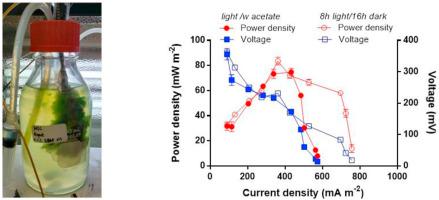Journal of Power Sources ( IF 9.2 ) Pub Date : 2020-11-20 , DOI: 10.1016/j.jpowsour.2020.229222 Jae-Hoon Hwang 1 , Hodon Ryu 2 , Kelsey L Rodriguez 1 , Saisaban Fahad 3 , Jorge Santo Domingo 2 , Akihiro Kushima 3 , Woo Hyoung Lee 1

|
Microbial fuel cells (MFCs) have recently been applied to generate electricity from oily wastewater. Although MFCs that utilize microalgae to provide a self-supporting oxygen (O2) supply at the cathode have been well discussed, those with microalgae at the anode as an active biomass for treating wastewater and producing electrons are still poorly studied and understood. Here, we demonstrated a bilgewater treatment using single- and double-chamber microalgal fuel cells (SMAFC and DMAFC) capable of generating energy with a novel microalgal strain (Chlorella sorokiniana) that was initially isolated from oily wastewater. Compared to previous MFC studies using green algae, relatively high voltage output (151.3–160.1 mV, 71.3–83.4 mV m−2 of power density) was observed in the SMAFC under O2 controlled systems (i.e., acetate addition or light/dark cycle). It was assumed that, under the O2 depletion, alternative electron acceptors such as bicarbonate may be utilized for power generation. A DMAFC showed better power density (up to 23.9%) compared to the SMAFC due to the separated cathode chamber which fully utilizes O2 as an electron acceptor. Both SMAFC and DMAFC removed 67.2–77.4% of soluble chemical oxygen demands (SCOD) from the synthetic bilgewater. This study demonstrates that the application of algae-based MFCs is a feasible strategy to treat oil-in-water emulsion while generating electricity.
中文翻译:

使用光合微藻燃料电池 (MAFC) 从舱底水发电的策略
微生物燃料电池 (MFC) 最近已被应用于从含油废水中发电。尽管利用微藻在阴极提供自支撑氧气 (O 2 ) 供应的 MFC 已得到很好的讨论,但在阳极使用微藻作为活性生物质来处理废水和产生电子的 MFC 的研究和理解仍然很少。在这里,我们展示了一种使用单室和双室微藻燃料电池(SMAFC 和 DMAFC)处理舱底水的方法,该燃料电池能够利用最初从含油废水中分离出来的新型微藻菌株( Chlorella sorokiniana)产生能量。与之前使用绿藻的 MFC 研究相比,相对较高的电压输出(151.3–160.1 mV,71.3–83.4 mV m -2在 SMAFC 中,在 O 2控制系统(即醋酸盐添加或光/暗循环)下观察到功率密度的变化。假设在 O 2耗尽的情况下,替代电子受体(例如碳酸氢盐)可用于发电。与 SMAFC 相比,DMAFC 显示出更好的功率密度(高达 23.9%),这是由于分离的阴极室充分利用 O 2作为电子受体。SMAFC 和 DMAFC 都从合成舱底水中去除了 67.2-77.4% 的可溶性化学需氧量 (SCOD)。该研究表明,基于藻类的 MFC 的应用是一种在发电的同时处理水包油乳液的可行策略。



























 京公网安备 11010802027423号
京公网安备 11010802027423号